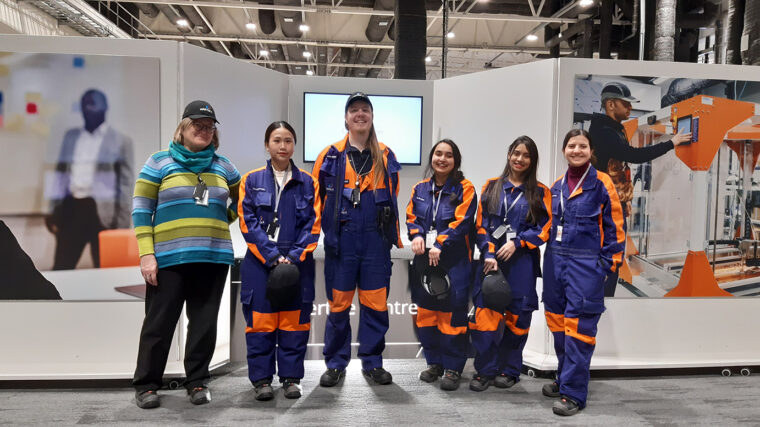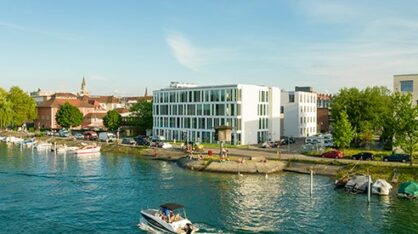Background and subject of the study
The idea for this research, which investigates the effectiveness of different training methods and especially the use of virtual reality in training (“Effectiveness of Virtual Reality in Wärtsilä Internal Technical Training: Higher Education Learners’ and Instructor’s Perspectives”), originated when Vida Shokati, who was interning at Wärtsilä, began to inquire about the possibility of conducting her master’s thesis research at Wärtsilä. Vida, who already held a master’s degree in English language teaching from Iran, was interested in exploring real-world problems and particularly the effectiveness of training methods, an area she had already studied in her first thesis. At Wärtsilä, Vida met with the head of WLSA, with whom she found a shared research interest because Wärtsilä has been investing significantly in virtual reality and training facilitated through it. There was a desire for more research data and concrete training experiences regarding the effectiveness of this learning environment. There was a need for more researched information on what the most effective way is to train Wärtsilä’s customers and their own maintenance personnel in performing engine maintenance procedures. With the help of new technologies, training can now be conducted in ways other than traditional physical training facilities, involving hands-on activities in engine maintenance. Due to the COVID-19 epidemic, remote teaching tools and software have advanced greatly, and with more powerful computers and new simulation software, the construction and use of virtual reality models, etc., have become possible. Additionally, new types of engines are entering the market, but it is not possible to acquire all new engine versions for WLSA’s training centers. Therefore, new training methods need to be introduced, and virtual reality as a learning environment is one promising possibility. It may also potentially save on training costs and yield better learning outcomes. However, it is necessary to determine how virtual reality works in practice and what learning outcomes it achieves compared to traditional training methods.
The study has two research questions:
- How effective is the use of virtual reality in learning theoretical knowledge about the engine itself and the process of removing the piston? (this was chosen as a concrete procedure to be trained for the subjects)
- How effective is the use of virtual reality in learning practical skills, i.e., actually removing the piston?
These research questions are addressed through experimental research, where the subjects were international energy technology students from the second year of VAMK’s English-language program, divided into 3 different groups (each group consisting of 5 students), and each group received their own four-hour training session on Wärtsilä engines and the process of removing the piston from one engine type. The training for the first group took place entirely online via Teams (see Figure 1), and videos and animations were also used. Other participants than the trainer himself have been removed from the screenshot.

The second group participated in hands-on training on-site at WLSA’s facilities. They studied engine parts and operation next to the engine itself, and they performed the concrete maintenance procedure being studied under the guidance of the instructor, using the maintenance manual as a reference. In Image 2, part of the contact teaching training group is seen at Wärtsilä`s Sustainable Technology Hub (STH) after the training session, with WLSA`s Trainer Harry Johansson, VAMK´s representative Principal Lecturer Lotta Saarikoski, and Åbo Akademi´s Master’s student Vida Shokati.

The third group also attended on-site at WLSA’s facilities but in a different space, immersed in a virtual world where the same topics and procedures were covered as in the previous two groups. The students and the trainer wore virtual reality headsets and hand controllers, and the training itself took place entirely in virtual reality, where a model of the Wärtsilä engine and its entire environment were simulated. In Image 3, two students from the group are seen participating in the training conducted in virtual reality.

Following their respective training sessions, each group of students underwent a 4-hour-long test the following day. The tests included assessing theoretical knowledge in the classroom (see Image 4) and then both theoretical knowledge and practical skills around a real engine. In total, the training and testing for the three groups spanned four working days. Additionally, the researcher conducting the study interviewed the virtual reality subjects individually.

Progression of the study
The study has involved several phases, and the planning of the experimental setup began in the fall of 2023 when Minna Lähteenmäki, the Director of WLSA’s Finnish Training Center, contacted Lotta Saarikoski at the beginning of November, inquiring about VAMK’s willingness and possibility to participate in such an experimental study. As a pedagogical mentor and an enthusiastic teacher interested in new teaching methods, Lotta was excited about the idea and started exploring a suitable “guinea pig group” among the engineering students. Energy technology lecturer Shekhar Satpute, also enthusiastic about developing teaching methods, joined the project, and together they found a suitable group, ETE2023k, with which this research could be conducted. The English-language energy technology- group was selected as the subjects of the study because it was desired to have a group that may not have much prior knowledge about engines and their maintenance procedures and for whom the use of English in education is daily practice. Additionally, this presented the entire class with a great opportunity to visit Wärtsilä because the first testing, aiming to find as homogenous a test group as possible (15 students), took place at STH on November 30, 2023, and at the same time, the students were introduced to Wärtsilä’s operations and technical documentation, which was part of the course taught by Shekhar that semester. This was the entire class’s first tangible encounter with the local industry. We essentially hit two birds with one stone. The group had been studying remotely in the spring of 2023 and started their studies in Vaasa only in the fall of ’23. Before the visit to Wärtsilä, Shekhar handled the research permits and other formalities for conducting this research. As the group supervisor, he also efficiently handled informing the class and gathering necessary information, among other tasks.
The first phase of the study was thus screening a homogenous test group (15 students) from the class, which consisted of about 40 individuals. The aim was to avoid selecting students with extensive experience in installation work and engines or individuals who might not be interested in practical “screwing” or might be averse to such activities. The group formation was done through a pre-test consisting of a set of questions, conducted electronically on Microsoft Forms during the visit to Wärtsilä. After the test, based on the answers, Vida and her supervisor formed the most homogeneous test group using statistical methods.
The subsequent phases of the study included scheduling and organizing safety training for the selected subjects (see Image 5) on week 6 and arranging the class schedule for week 7 of the spring semester so that the groups could visit Wärtsilä without overlapping with their classes. Fortunately, we were proactive, and the scheduler managed to accommodate these requests in the spring schedule, which worked out very well for the study.

As mentioned in the previous paragraph, each five-member test group participated in their respective training sessions, and Lotta had the opportunity to observe these trainings and partly the testing situations as well. As of writing this piece, the analysis of the results has only just begun, and the final results will be ready by May. More details will be written about them once Vida’s thesis is completed. The results will also be presented to the class and other interested parties at VAMK in late spring.
Participants’ comments
The practical implementation of the study went well. Vida Shokati (second from the left in Image 6) and Minna Lähteenmäki, the Director of WLSA’s Finnish Training Center (second from the right in Image 6), had organized the schedules, transportation, testing, and other practical matters excellently. The students were very enthusiastic, and all of them mentioned that they had learned a great deal, not only about Wärtsilä’s engine types but also about the theoretical aspects of combustion engines and practical installation work. A significant role in the training itself was played by trainer Harry Johansson (on the right in Image 6), whose calm and encouraging style clearly produced good learning outcomes. The trainer also had an excellent ability to explain complex theoretical concepts in a down-to-earth and concrete manner. Trainer Edvard Krooks (on the left in Image 6) also participated in the hands-on training as well as the final testing for all groups. Overall two Wärtsilä trainers were present.

A significant contribution to the construction of the virtual reality training model and the organization of the virtual training event itself was made by Kasper Söderlund, Senior designer in the training development. Image 7 shows one part of the virtual model which Kasper has been creating with his team. Their virtual model was used in this research.

According to trainer Harry Johansson it has been valuable in this study to gain a fresh perspective on education through the students. It has been interesting to see how someone with limited experience in the subject learns. Viewing things from a new perspective easily reveals new challenges that trainees may face. This study has also highlighted the importance of considering safety aspects when observing a novice’s learning and behaviour in a concrete hands-on situation. According to trainer Edvard Krooks, it is fascinating to see the various ways in which people can learn, and especially how virtual reality can aid learning. Senior designer Kasper Söderlund is particularly interested in the functioning of virtual reality and models, which he has been developing at Wärtsilä for over five years. He is especially interested in how much of the training can be based on virtual models and what is the right combination of practical hands-on training, virtual reality, and other materials, such as videos, e-learning, or AR (augmented reality). Minna Lähteenmäki, on the other hand, commented that this research collaboration is very important for Wärtsilä in order to to obtain concrete information on the effectiveness of virtual reality and the best ways to utilize it. Therefore it is important to get researched information on this topic, and it was really great that such a unique collaborative project was launched. This research arises from practical needs, and the tripartite research collaboration between Wärtsilä, VAMK, and Åbo Akademi implemented here is truly wonderful.
Follow-up actions
As of writing this piece, Vida has started analyzing the results and writing her thesis. We eagerly await the results. The reporting of the research will be completed by May 2024, and the intention is also to write a conference article and present this research at a European engineering education conference or other event. The results will also be presented in all three organizations. If anyone becomes more interested in using virtual reality in education, they can start by exploring what Philippe et al. (2020) or Hu-Au & Lee (2017) have written on the subject. The virtual education student group in Image 8, like all other participating students and VAMK, thanks Wärtsilä and Vida Shokati, as well as Åbo Akademi, for this excellent joint research project. Hopefully, in the future, we will find similar joint research projects or other joint development projects related to the pedagogical development of education. This project was a wonderful new addition to the active co-operation between VAMK and Wärtsilä.





